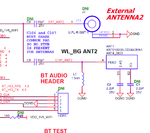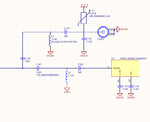ctzof
Full Member level 3
Hello,
I am more or less new to this. I want to insert two antennas to TI's WL1801MOD. The first antenna is a chip antenna ANT016008LCD2442MA1 and the other one an external antenna connected to a 50 ohm cable through a connector. What should I have to consider in this design. Just design 50 ohm impedance line from the chip to the antennas is enough or I have also design a matching network. Does the length of the line plays any particular role when designing a matching network. I'll also have to meet the FCC requirements for WLAN. You can take an idea of what I want to do by looking in the attached picture. I don't know if the circuit is correct I've more or less copied other designs from evaluation boards. Can anyone help me with this? Thanks.
- - - Updated - - -
This is the picture
I am more or less new to this. I want to insert two antennas to TI's WL1801MOD. The first antenna is a chip antenna ANT016008LCD2442MA1 and the other one an external antenna connected to a 50 ohm cable through a connector. What should I have to consider in this design. Just design 50 ohm impedance line from the chip to the antennas is enough or I have also design a matching network. Does the length of the line plays any particular role when designing a matching network. I'll also have to meet the FCC requirements for WLAN. You can take an idea of what I want to do by looking in the attached picture. I don't know if the circuit is correct I've more or less copied other designs from evaluation boards. Can anyone help me with this? Thanks.
- - - Updated - - -
This is the picture



